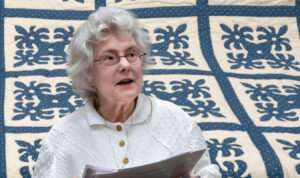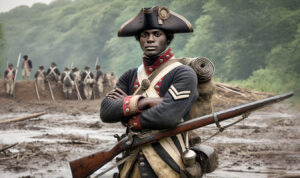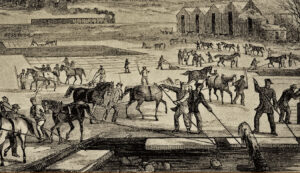An Evening of Quilt History With Janet Burr
A Meetup of the Gloucester County Historical Society and the South Jersey Quilter’s Guild

Janet Burr, an Emerita Trustee of the Gloucester County Historical Society (GCHS) and a widely acknowledged expert in the history, methods and lore of quilts and quilting, was the featured speaker at a March 12 quilting event sponsored by the Franklin Township Library.
Burr, who, curiously, is not herself a quilter, has spent decades studying the history, materials, techniques and meanings of quilts, now recognized as works of art as well as unique tangible records of the social and cultural history of the Delaware Valley. She is a co-author of the new book Threads Through Time: Quilts of the Gloucester County Historical Society.
The event was attended by members of the South Jersey Quilters Guild.
Centuries of Heirloom Quilts Displayed
Accompanied by Trustee and Chair of the GCHS Library Committee Lee Hansell, Burr brought a carload of historic quilts from her own collection as well as that of the Historical Society to display and visually accompany the points of her presentation. The quilt collection of the Historical Society is one of the region’s most extensive and contains quilts dating from the 1700s to the present day.
Personally demonstrating how quilts often become cherished family heirlooms passed down through generations, Burr presented striking quilts made by her mother, friends of her daughter, her husband’s grandmother, her great-grandmother’s gift quilt for her parents’ wedding, and her husband’s aunt’s crib quilts for both her daughter and son.
The final one she displayed was an 1841 quilt made to celebrate the wedding of her husband’s great-great-grandparents. It has since been passed down through the Burr family for more than a century. [Text continues below images.]
Different Types of Quilts
For those in the audience unfamiliar with quilting, it was surprising to learn from Burr how many different kinds of quilts exist. They include:
• Appliqué quilts, made with a method that uses smaller fabric pieces sewn onto a larger background to create designs and patterns. This style has been popular with American quilters since the 1700s.
• Patchwork quilts, which involve sewing large numbers of small fabric blocks together to create a whole fabric sheet. These blocks are often in geometric shapes that form intricate patterns across the quilt.
• Autograph quilts, textile creations featuring the signatures of their makers or sponsors written in ink, embroidered or stamped onto fabric squares. These were very popular during the 1800s.
• Album quilts, often made by groups of quilters, each of whom created appliqués of their own design to ultimately form a large mosaic of unique images that often captured the essence of a theme, event or place.
• Strippy quilts, as their name implies, simple quilts consisting of long strips of fabric sewn together in rows running the length of the quilt. The stripes usually feature alternating colors or fabrics of high contrast.
• Knotted quilts, in which layers are secured together using knots rather than traditional quilting stitches. A thread, yarn or ribbon is passed through the layers and tied into knots at regular intervals to accommodate thicker batting.
• Crazy quilts, wildly colored and patterned “fancywork” or luxury creations popularized in Victorian times. They celebrate the rich fabrics, exuberant designs and highly versatile needlework of their makers.
• Stenciled quilts, whole-cloth quilts whose surfaces have been decorated with designs or patterns applied through stencils with various kinds of inks or, in the modern age, acrylic paints.
• White Marseilles quilts, featuring delicate stitched designs that are stuffed with cording to create intricate raised patterns. The technique was developed in France in the 1600s and became popular in the American colonies in the 1700s.











